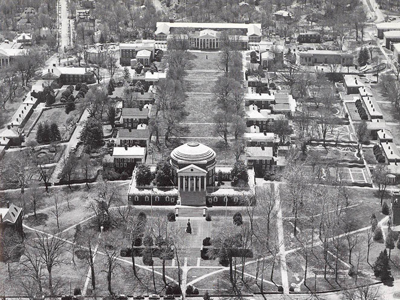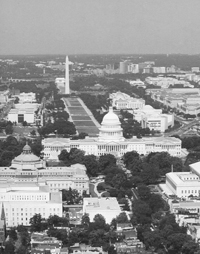You are in: Home page > Magazine Archive > Campus and City

View of the University of Virginia Campus
Abstract
The university component is strategically indispensable in the development of a knowledge economy, one where research is the basis of every production lab characterized by innovation, where the university campus type becomes a poleogenetic tool, of necessity complementary to the city context and pre-existing local circumstances
Text
The “campus”
theme is unquestionably among those that have characterized the recent history
of architectural design with regard to those aspects closest to the ontological
meaning of the city. First and foremost that of community, if it is true that
the main causal factor of the urban phenomenon is the required community, that
of economic and socio-political implications, including cultural adaptation. An
attention-seeking by the city, as Max Weber has taught us, that can extend its
role to other more vast community patterns, linked to larger areas or otherwise
as far as identification with a nation in a geopolitical sense goes or,
nowadays more often in a geo-relational way with respect to a network of
homologous centres. If we start off from these presuppositions between campus
and city, the idea, but also the formal type of campus, can be historically
detected in the founding processes not only of a city but even of an entire
nation. In the American context, for
example, as Paul Venable Turner has demonstrated rather well [1], the campus
theme is original and formally more defined with respect to that of the city
which, in the initial stages of the birth of a nation, is still limited to the
agglomerate of a village or at most to the scheme of the colonial layout. Moreover,
the very idea of the city as an expression of a representative centrality sees
the formal elaboration of the university campus superimposed on the city, as in
the case of the American capital cities, and Washington in particular [2]. Then
again, the American episode of the symbiotic relationship between campus and
city is also symptomatic of the potential of a university community that uses,
but at the same time reproduces, many aspects of urban phenomenology.
Certainly, in the European case, in more organic terms to the rebirth of the
urban phenomenon, starting from the medieval phase, hence less distinguishable per se since undertaken within a
socio-political and economic structuring that can autonomously identify the
required functional and representative components: from the building of
cathedrals to municipal palaces and the market squares of the bourgeois
community up to the urban fortifications of the aristocratic classes. In
every case, the awareness that should accompany those who operate today on the
university campus theme is of a poleogenetic instrument continually employed
throughout the historical course of the city and perhaps by now charged with
further responsibility in several ways.Suffice to
think how the university component is strategically indispensable in the
development of a knowledge economy, one where research is the basis of every
production lab characterized by innovation. Whence the development of the grand
university settlements in Anglo-Saxon circles, currently replicated by the new
protagonists of socio-economic growth on a global scale, as settlement centres
of technologically advanced societies and where transfer of technology is
carried out reciprocally. In what is, in some ways, only apparently the
opposite direction, campuses frequently become places of experimentation on
behaviour but also technologies that can guarantee an eco-sustainability that
is as highly demonstrative in practice no less than in its ideological
elaboration. Nonetheless,
between the techno-campus and the eco-campus the university complex intercedes
as an instrument of a developmental projection, of a wish to be a future city.Bowing to
this complex vocation, in demonstration of the permanent attention-seeking
behaviour of the campus in becoming a city, the question that ensues is how
this role is characterized in the Italian settlement scenario. Beyond a
constant integration with the historical urban fabric and the great monumental
edifices that immortalize it, to the point of identifying as university
campuses sizeable portions of the historical nuclei of Italian cities, the
university campus settlement has also seen independent creations that remain
complementary to an existent city or regional situation. Whether in cases that
mark the relationship with the surroundings such as Chieti or Arcavacata in
Calabria, or when the dialectic of the relationship is with the city, in the
urban addition of Piacentini's Sapienza Campus in Rome or, on quite a different
scale, in De Carlo's reproduction of a Central Italic village for his
university buildings in Urbino. The city and its surroundings, in the resulting
structural definition and landscaping, tend to summarize the campus' settlement
data, metabolizing its contribution within its own transformation physiology.
It follows that in the Italian context it is difficult to acknowledge a
specialized, or even an alternative role for the university campus pole in an
urban sense. If
anything, it is in the concepts of complementarity, integration, and
superimposition on the city that we can rediscover the dialectic reasons for a
contextualized characterization of the “Italian-style campus”. The
University of Parma's Mastercampus project starts off from these
presuppositions and draws two main guidelines from them in support of its
advancement [3]. The first is that of a strategic consideration of the
university settlement applied to the entire urban fabric, from historical
nucleus to the inner suburbs and the suburbs proper. The medium-sized city, the
features of urban sprawl projected out into the surroundings constitute the
premises for a multiplication of university settlement hubs, where the very
idea of “campus” is multiplied and efficiently characterized, from time to
time, in the events of the historical fabric, in the hospital complex rather
than the area in between a heavily anthropized region, merely due to
consolidated rural activity, and the outskirts girded by the ring road. In this
condition, the strategic nature of the campus is purely urban in the way it can
structure pieces of city and the surroundings by strengthening them,
introducing attraction factors, centrality logic, urban hierarchy. The second
establishes a critical relationship with the city on the demonstrative plane as
regards certain critical points, presupposing a positive knock-on effect for
the context. This is the case for the redevelopment of the historical fabric
where the interventions of the Campuses in the Oltretorrente neighbourhood and
the Centre can help combat the phenomenon of deconcentration of the city's
central nucleus, which we find in the decentralization of tertiary and
administrative functions rather than in the deterioration of the mercantile
network. Or, as in the Science and Technology Campus, with its academic
community consisting of lecturers, researchers and students who make use of
their own capacities for self reflection to express an integrated design
approach focused on establishing a novel construction for an urban
neighbourhood sooner than a campus, with all the multiple aspects that the
various scientific sectors can express: from environmental sustainability to
alternative mobility, from habitation patterns to the way public space is used.
In
the crossfading between campus and city, the tools of architecture, once again
in the transcalar and diachronic sense of Italian tradition, can make a
fundamental contribution to urban transformation, employing the university
component as a decisive resource for the city's layout and landscape.
Note
[1] Paul Venable Turner, Campus: An American
Planning Tradition, MIT Press Cambridge, 1984
[2] Carlo Quintelli, L’architettura del
centro, argomenti sull’identità capitale della città, Turin 1996
[3] To see the range of activities in the Mastercampus strategy, visit
www.mastercampus.it
Carlo Quintelli, full Professor of Architectural and Urban Composition, he teaching at the Faculty of Architecture of Parma.
Since 2012, he has been vice director of the DICATeA, Department of Civil Engineering, Environment, Territory and
Architecture of the University of Parma.

View of Campidoglio in Washington














